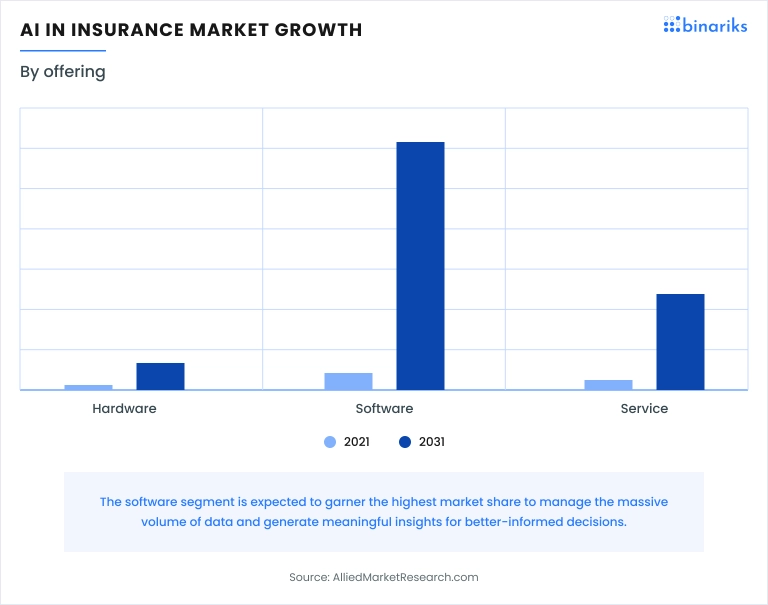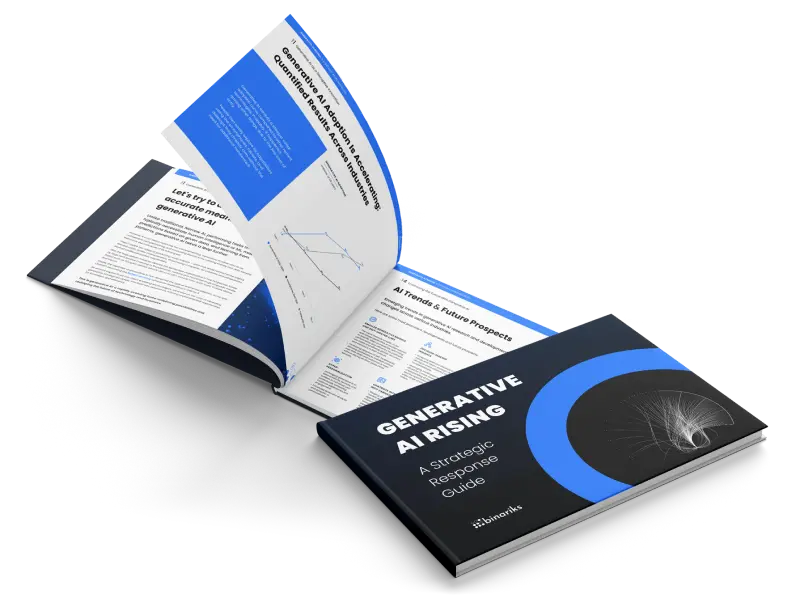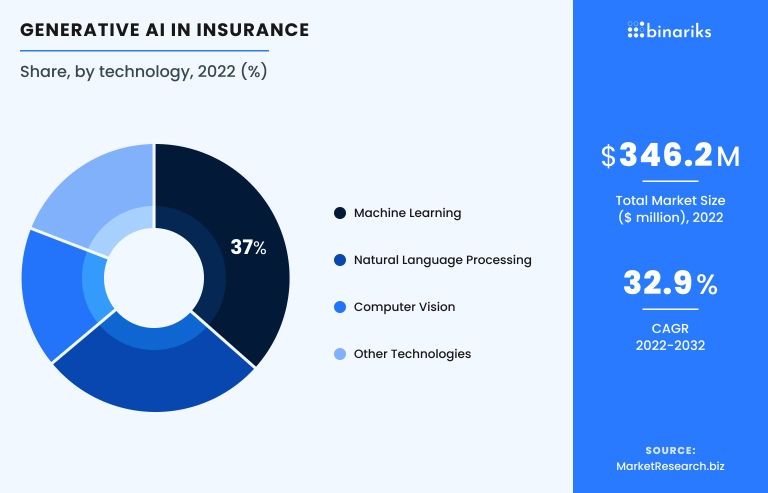In 2024, artificial intelligence will revolutionize every industry it encounters. In insurance, its value is to transform risk assessment accuracy, increase customer satisfaction , and streamline claims processing.
Here are some of the statistics that emphasize the role of artificial intelligence in insurance:
- 79% of insurance executives believe AI will revolutionize customer interactions (Source ).
- AI is expected to improve claims processing by 30% (Source ).
- AI is projected to contribute $1.1 trillion by 2035 (Source ).
- 87% of insurers believe AI will enhance underwriting (Source ).
- The market is projected to reach $45.74 billion by 2031 at a CAGR of 32.56% (Source ).

In this article, we focus on the benefits of artificial intelligence for insurance and AI in insurance use cases, as well as existing solutions and potential challenges.
Benefits of AI adoption for insurance
All benefits of artificial intelligence in insurance make services cheaper, more efficient, and more customer-friendly. Let's discover details of the impact and advantages and impact of insurance analytics and AI alliance:
- Improved risk assessment: AI algorithms can analyze vast amounts of data, including non-traditional data sources, and assess risks. You can train AI for insurance on your demographic data. The adoption of artificial intelligence in insurance results in better pricing models and underwriting processes. Also, they help detect fraud.
- Enhanced customer experience : AI-driven chatbots and virtual assistants provide 24/7 customer support. Personalized AI recommendations can also tailor insurance products to individual customer needs.
- Efficient claims processing: AI in insurance can automate and streamline the claims processing workflow. This reduces manual intervention and speeds up the resolution of claims. The result is a cheaper process and higher customer satisfaction.
- Fraud detection and prevention: AI in the insurance industry can detect patterns and anomalies that may indicate fraudulent activities. They analyze historical data faster than any other current method.
- Operational efficiency: AI in the insurance industry offers automation and automatization through automation and optimization of various processes. As a result, it reduces costs and frees up human resources for more complex tasks.
- Data-driven insights: AI can process and analyze large datasets to provide actionable insights. This helps with strategic decision-making and new market opportunities.
- Personalized marketing: Marketing is, in fact, a critical application of artificial intelligence in insurance. AI enables more targeted and personalized marketing campaigns with better customer data.
Will adopting GenAI mark the next chapter for your business?
Download our free whitepaper now to find out.

AI technologies that are used in insurance
NLP
Natural Language Processing (NLP) is an AI technology that helps AI understand human language. In the context of AI for insurance, it has a variety of apps, for example:
- It is used in chatbots and virtual assistants to interact with customers and proceed with their queries quickly.
- NLP benefits claim processing by extracting information from claim documents and data sources.
- NLP analyzes the sentiment in customer messages for a more nuanced and faster reaction. For example, if the customer is visibly upset judging from their message, they may prioritize their query.
Generative AI
Generative AI in the insurance sector, like GPT-4, Bard, and Gemini, can create personalized insurance product offerings and marketing materials by mimicking customer preferences. It can also assist in detecting fraud.

Predictive modeling
Predictive models forecast future outcomes based on statistical techniques that use historical data.
Predictive models are used to assess the risk profile of clients, which is a massive plus for underwriting. They can also predict behaviors such as the likelihood of policy renewal or cancellation. The severity of customer claims can be forecasted based on predictive modeling.
Machine learning and data analytics
Machine learning algorithms can process vast amounts of very different data in the underwriting process.
Big data gives insights into everything from market trends to operational efficiency needs.
Robotic process automation (RPA)
Robotic Process Automation (RPA) is a technology that automates repetitive, rule-based digital tasks by mimicking human interactions with insurance software applications.
As artificial intelligence for insurance, RPA is used to automate tasks. This is usually helpful for administrative tasks and data entry. By eliminating manual work, RPA in insurance reduces processing time by up to 80%, minimizes human error, and frees staff to focus on complex decision-making and customer service rather than administrative busywork.
Image recognition and processing
In auto or property insurance, image recognition can be used to assess damage from photographs. This helps to speed up the claims process.
Take your software to new heights with AI/ML solutions
Top 12 insurance AI use cases
We have dived into the benefits of artificial intelligence in the insurance industry and the types of technologies used, but how exactly are these technologies used? Let's look into some real-life examples.
1. Claims processing
- An example of AI in insurance use cases is the flight company AI model that can accurately predict that a flight will be delayed.
- An application that processes the claim by scanning the vehicle, accessing the driver's driving style, and predicting the details of an accident.
- Shift Technology uses an app that categorizes claims based on severity and complexity.
- Companies like Lemonade use AI for fast claims processing.
2. Submission intake
- Firms like Zest use AI to analyze submission documents for fast data entry.
- Insurtechs leverage AI to perform initial checks on submissions and check them for eligibility.
3. Policy review and management
- Companies use AI in the insurance industry to personalize insurance policies based on customer data analysis. PolicyGenius is an excellent example of that.
- Earnix uses predictive analytics to forecast policy renewals or cancellations. This is an excellent instrument for the prediction of retention.
4. Risk engineering
- Underwrite.ai employs AI models to assess and predict risks for better underwriting decisions.
- Octo Telematics uses AI for predictive maintenance of insured assets with the help of IoT devices installed into vehicles.
5. Detecting fraud
- SAS's AI solutions continuously monitor transactions to detect and prevent fraud 24/7.
6. Customer engagement
Insurify's chatbot, running on AI technology, handles customer queries and policy information around the clock.
7. Pricing strategies
ZestFinance's solutions use AI for the insurance industry to create dynamic pricing models considering individual risk profiles.
8. Data-driven insights for strategic planning
Atidot utilizes AI tools to analyze market data for strategic planning. AI-driven insights into customer behavior patterns help in developing customer-centric products.
9. Regulatory compliance
Solutions like Ascent use AI to ensure compliance with the latest regulations in the USA.
10. Personalized insurance policies
Metromile offers pay-per-mile auto insurance where premiums are based on the actual driving distance based on telematics data.
11. Determining property risks
Cape Analytics uses AI and aerial imagery to assess property risks for insurers. This includes information about roof conditions and the size of a property.
12. Selecting health benefit plans
Platforms like Policygenius use AI to recommend health insurance plans by comparing different options and highlighting the best fit for the customer's needs. The factors that might be included in this include medical history and current health status.
Collision management platform
We built a scalable front end for insurtech apps and added several new features for the client's software
Some examples of AI solutions for insurance
Several artificial intelligence solutions in the insurance sector are being developed right now. Here are some examples of AI solutions that are currently used:
Chatbots and virtual assistants
- Example: Insurify, Lemonade's AI Maya
- Functionality: These AI-driven chatbots and virtual assistants interact with customers for basic customer service. They can simultaneously handle a high volume of customer interactions.
Automated claims processing systems
- Example: Tractable, Shift Technology
- Functionality: These systems use AI to automate and streamline the claims handling process. They can assess damages (using photos and videos for auto or property claims) and validate claims.
Fraud detection platforms
- Example: FRISS, SAS
- Functionality: These platforms use AI and machine learning algorithms to detect patterns and anomalies that indicate fraudulent activities. They analyze claims and transactions in real time to look for potential fraud.
Underwriting and risk assessment tools
- Example: ZestFinance, Underwrite.ai
- Functionality: These tools use AI to analyze traditional and non-traditional data sources for risk assessment and underwriting. They help create more accurate risk profiles and pricing models.
Predictive analytics for customer behavior
- Example: Cogito, Earnix
- Functionality: These solutions use AI to predict customer behavior (policy renewals or cancellations). They help to improve retention.
Policy management and administration platforms
- Example: Planck, PolicyGenius
- Functionality: These platforms utilize AI to help insurers manage policy (personalization of policies, regulatory compliance, and policy administration tasks).
Telematics and IoT-based solutions
- Example: Octo Telematics, Metromile
- Functionality: These solutions use telematics and IoT devices to collect real-time data for usage-based insurance (UBI). They are ubiquitous in auto insurance, where they track driving behavior for risk assessment and personalization of offers.
Data analytics and insight tools
- Example: Cape Analytics, Atidot
- Functionality: These tools analyze vast datasets to provide actionable insights for insurers. This helps to understand market trends and customer needs.
Image recognition and processing for claims
- Example: PicSee, EagleView
- Functionality: These solutions use image recognition to assess damages from photos in property and auto insurance claims. It results in faster and more accurate claims processing.
Regulatory compliance software
- Example: Compliance.ai, Ascent
- Functionality: These software solutions use AI to track changing regulations and ensure that insurance products and practices remain compliant.
If you feel like the AI and insurance solutions covered in this article are not what you're looking for or are not enough to adequately respond to the unique needs of your business, you can create custom AI /ML solutions with an experienced team like Binariks .
Embrace InsurTech innovation with custom software development
AI adoption challenges in insurance
AI for insurance companies is now an unparalleled way of making experiences faster and easier. However, some significant limitations remain, as AI can't work for everything. Moreover, there are some significant roadblocks in the process of development . Here are some things to know about:
- Generative AI and other AI software make mistakes and are not trained for everything at once. Likewise, the tools that are trained on the data from the Internet very often reflect Internet biases. One thing to make of it is the need for competent human professionals working with all AI in the insurance sector.
- AI in insurance cannot handle the most complex tasks associated with underwriting. This specifically pertains to the cases where there are a lot of human variables like age and medical history. This is because artificial intelligence in insurance is trained on hard data. AI simply cannot assess an individual's character or lifestyle choices in tasks like life insurance.
- The use of AI in insurance goes through the hoops of regulatory compliance. The insurance industry is heavily regulated and will be even more regulated. Ensuring that AI applications comply with existing laws and regulations is a significant challenge with many new legislation and technologies. For example, the European Union is awaiting the arrival of the new AI Act , which will change the regulatory aspect of artificial intelligence and insurance.
- Insurance analytics and AI require high-quality, accurate data to function effectively. Insurers often struggle with legacy systems and siloed data, making accessing and integrating data across different departments challenging. That is where proficiently crafted AI solutions for insurance , such as those developed by experts like Binariks, can prove invaluable.
- There is often a gap in the necessary skills within the workforce to manage AI solutions. Training current employees and recruiting new talent with AI expertise is challenging for many insurers.
- Gaining customer trust in AI-driven decisions, especially in critical areas like claim denials or policy pricing, is challenging. Customers may be skeptical of decisions made by algorithms rather than humans. This is especially true for older demographics (consumers aged 58-76).
Final thoughts
In conclusion, AI in the insurance industry represents a transformative force that is impossible to deny. Despite challenges, dozens of AI technologies in the AI sector improve accuracy, speed, and overall experience for millions of insurance customers worldwide.
There is a growing integration of AI tools across various aspects of insurance , from claims processing to fraud detection. Throughout the 2020s, we will see more risk and balancing of opportunities for AI in the insurance industry. Physical robotics, open-source data, and IoT will add more to the existing AI architecture in insurance.
For insurers, all of this means that 2024 is the time to leverage the power of AI and choose which technologies will benefit their company and customers the best. The guide above is an excellent representation of what one can expect from different tools. Yet if these tools do not completely cover your needs or you want expert advice – no problem. Binariks is here to help develop and train AI models and integrate AI with your existing systems.
Share

